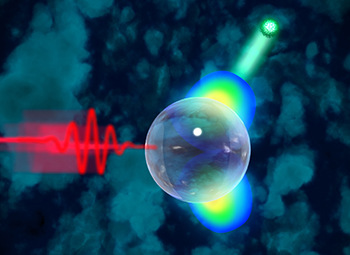
Femtosecond laser pulses (red) directed at glass nanospheres cause electrons (green) to accelerate and escape from the enclosed group of atoms. Credit: Martin Dulovits / woogieworks
An international team of scientists led by physicists at Ludwig-Maximilians Universität (LMU) in Munich, Germany, has investigated the attosecond dynamics of SiO2 nanospheres to characterize their near-field behavior and enable precision control of the direction of electron emission (Nat. Comm., doi:10.1038/ncomms8944). The near-field is the region of electromagnetic influence near the surface of an object, in this case, silica nanospheres with diameters ranging from 50 to 550 nm, chemically synthesized in the lab of Eckart Rühl, professor of physical chemistry at Freie Universität Berlin.
A team led by Matthias Kling, professor of physics at the Max-Planck-Institut für Quantenoptik (Garching, Germany) and LMU, directed a 720 nm wavelength laser pulsed at 4 fs for a few cycles at a stream of single nanoparticles to cause the electrons inside to oscillate at the surface. The oscillations produce nm-scale near fields that pulsate and then catapult electrons with attosecond precision. The strength of the near-field catapult effect increases with the diameter of the nanospheres.
Thomas Fennel, professor of physics at the Universität Rostock, Germany, who conducted simulations on the emission, likens the observed effect to a ping-pong game on the nanosphere surface that bounces the electrons off the surface of the sphere briefly; when they return, the near-field provides a strong kick of momentum that releases them for good. The direction of the emission is controllable with lasers, which may lead to strongly steerable X-ray imaging.
With strong enough laser pulses, whole ions could be released, which could enable directable radiation for cancer therapy. The technique may also lead to new materials processing techniques at size scales below the diffraction limit, and “light-wave electronics” with data computing cycles 100,000 times faster than current computers.
